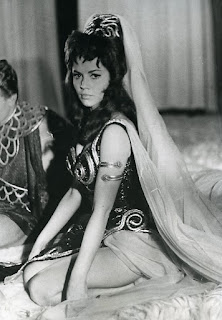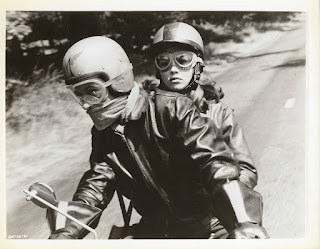British Quad Poster
Two and Two Make Six (aka The Girl Swappers) is a British comedy directed in black and white by Freddie Francis. Larry (George Chakiris), a U.S. airman, is a ladies man that also likes to bet on the horses. He seems to always been in trouble with his Sergeant (Bernard Braden), and his current fling is Julie (Jocelyn, as Jackie Lane). Larry gets a tip from a young girl who works at a horse stable, and he wins 250 pounds at the track. Unfortunately, the girl's mother considers him to be a "molester" and reports him to the Sergeant, which results in a confrontation in the lady's home. When Larry pushes the Sergeant down, a vase falls on his head, and the lady starts screaming that Larry has killed him (though he is really only unconscious). Larry panics and flees the scene, seeking help from Julie to flee the country and return to the U.S.
Julie loans her brother's motorcycle to Larry, but she insists that he take her with him to the U.S., and Larry reluctantly agrees. The couple stops at a roadside cafe, and that's where the complications get worse. When policemen arrive at the cafe, Larry gets worried and hurries outside to get on the motorcycle. A fellow named Tom (Alfred Lynch) is also outside getting on his motorcycle, and the two guys are dressed the same (and have helmets, goggles, etc. that mostly cover their faces). While Alfred is examining his motorcycle and not paying attention, his girlfriend, Irene (Janette Scott) hops on the back of Larry's motorcycle as Larry hurries away. Julie then comes out and gets on the back of the motorcycle with Tom.
Each guy gets down the road a ways before realizing that the wrong girl is on the motorcycle with him. They try returning to the cafe to straighten it out, but the policemen are still present, so they do not stay there. Larry was traveling to Westport to hop a ship out of the country, so he decides to go there, thinking that Julie will come there and find him. Meanwhile, Tom and Julie decide to go to his Aunt's house in Seven Hills, because they think that Irene will take Larry there (although Irene does not know where his aunt lives).
Predictably, the couples at first deal with the situation by arguing, but they eventually start falling for their new traveling companions. Athene Seyler is particularly good as Tom's saucy Aunt Phoebe. After much confusion and effort, the couples eventually reunite but decide to remain with their new partners. Larry returns to the base to accept his punishment, and Irene convinces the Colonel there to go easy on him. In the final scene, we see both ladies strolling their babies together, presumably with Julie having married Tom and Irene having married Larry.
Two and Two Make Six is a pretty good movie, overall, and it is definitely a must-see for Jocelyn fans. Janette Scott was an attractive lady in this film, but for my money, she was not in the same class as Jocelyn. Jocelyn and Janette had both been amongst the crop of starlets seeking attention in the UK in the 1950's. Jocelyn clearly does not have black hair in this film; it is either red or brown. She had probably moved to the red color based on the British quad poster at the top of this post. She wears some sexy outfits, with Julie being a character that is interested in money and is very forward with the shy Tom. The character of Irene, on the other hand, seems to be a girl next door with a heart of gold.
This is the type of role that fit Jocelyn's skill set very well. She was good at light comedy, and I think that this role was one of her better acting jobs. She gets to smile and be happy a lot, but also gets to use some of her sly, sexy, petulant attributes, as well. I noticed that at times, her generally light British accent seemed to be a little more pronounced than at other times. That caused me to wonder if perhaps Jocelyn was a better actress than even I give her credit for being, because she was acting more "British." I have often wondered what type of accent she had in her everyday life, because she seemed to fairly easily have a light British accent, or no British accent, in her roles. Since she spent most of her formative years in New York, my presumption would be that she only had whatever degree of British accent she may have picked up after moving to England in her mid-teens.
Chakiris did a good job as Larry in the film, and it should be noted that he had just recently turned in his Oscar-winning performance in West Side Story. I thought Lynch and Scott did well also.
All-in-all, Two and Two Make Six is a modestly budgeted film that is worth viewing by any lover of retro cinema, but it's one that should not be missed by Jocelyn fans.
Filming commenced in Bristol, England in June of 1961 under the title
Change of Heart, and it was finished by August, based on reports in
Variety. The UPI wire service circulated a photo of Jocelyn on a fountain in Bristol with the caption: "What red-blooded man wouldn't put actress Jackie Lane on a pedestal? Actually, the statuesque British star climbed up on this herself in the historic English port city of Bristol, where she's filming 'A Change of Art.' Called 'Nails,' the waist-high bases were used as places where money changed hands between busy traders of the past, giving rise to the British expression, 'Paying on the Nail,' meaning paying immediately."
Re-titled Two and Two Make Six, the film was released in the U.K. in May of 1962. Based on reports in Variety, it seemed to perform fairly well at the box office over the rest of the year. Variety reviewed the film in its June 6, 1962 edition based on a viewing at the Leicester Square Theatre in London on May 29 (with a running time of 89 minutes), generally concluding that it was a "[f]limsy, but pleasant, comedy drama with a couple of engaging performances by young players which could help out satisfactorily as a dualer." As for Jocelyn, it assessed that she "was not in the same thesping league as her colleagues." It went on to praise Scott's work in the film, which baffles me as to how it was considered by the reviewer to be any better than Jocelyn's.
Two and Two Make Six was released on DVD in the U.S. in 2008 as The Girl Swappers, a title which makes the film sound more risque than it really is. The only extra on the DVD is a slideshow of scenes from the movie.
Here is a U.S. one sheet poster and lobby card set (courtesy of emovieposter.com):
Here are some U.S. stills:
A still of unknown origin:
Two and Two Make Six still
A British lobby card:
A British mini-poster:
A Belgian poster:
An Italian locandina:






















































